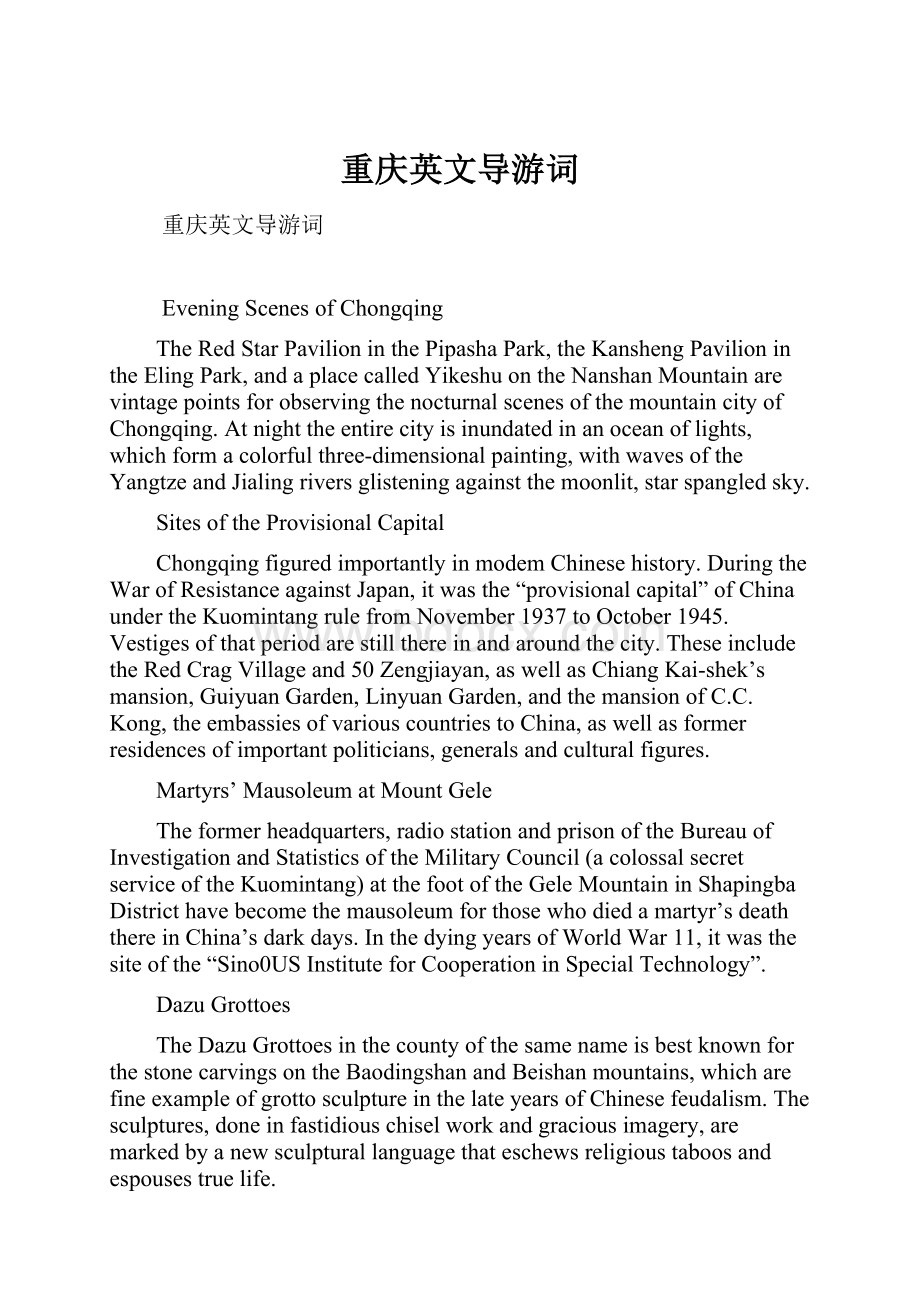重庆英文导游词.docx
《重庆英文导游词.docx》由会员分享,可在线阅读,更多相关《重庆英文导游词.docx(13页珍藏版)》请在冰豆网上搜索。

重庆英文导游词
重庆英文导游词
EveningScenesofChongqing
TheRedStarPavilioninthePipashaPark,theKanshengPavilionintheElingPark,andaplacecalledYikeshuontheNanshanMountainarevintagepointsforobservingthenocturnalscenesofthemountaincityofChongqing.Atnighttheentirecityisinundatedinanoceanoflights,whichformacolorfulthree-dimensionalpainting,withwavesoftheYangtzeandJialingriversglisteningagainstthemoonlit,starspangledsky.
SitesoftheProvisionalCapital
ChongqingfiguredimportantlyinmodemChinesehistory.DuringtheWarofResistanceagainstJapan,itwasthe“provisionalcapital”ofChinaundertheKuomintangrulefromNovember1937toOctober1945.Vestigesofthatperiodarestillthereinandaroundthecity.TheseincludetheRedCragVillageand50Zengjiayan,aswellasChiangKai-shek’smansion,GuiyuanGarden,LinyuanGarden,andthemansionofC.C.Kong,theembassiesofvariouscountriestoChina,aswellasformerresidencesofimportantpoliticians,generalsandculturalfigures.
Martyrs’MausoleumatMountGele
Theformerheadquarters,radiostationandprisonoftheBureauofInvestigationandStatisticsoftheMilitaryCouncil(acolossalsecretserviceoftheKuomintang)atthefootoftheGeleMountaininShapingbaDistricthavebecomethemausoleumforthosewhodiedamartyr’sdeaththereinChina’sdarkdays.InthedyingyearsofWorldWar11,itwasthesiteofthe“Sino0USInstituteforCooperationinSpecialTechnology”.
DazuGrottoes
TheDazuGrottoesinthecountyofthesamenameisbestknownforthestonecarvingsontheBaodingshanandBeishanmountains,whicharefineexampleofgrottosculptureinthelateyearsofChinesefeudalism.Thesculptures,doneinfastidiouschiselworkandgraciousimagery,aremarkedbyanewsculpturallanguagethateschewsreligioustaboosandespousestruelife.
YangtzeRiver’sThreeGorges
SailongdowntheYangtzefromChongqingtoYichangallowsvisitorstoseethespectacularsceneryoftheThreeGorgesalongwithitssplendidculturalheritageandfabledlocalfolklore.Thecruise,whichcombinessightseeingwithscientific,artisticandfolkloreexploration,isanational-calibertouristprogram.The193-km-longThreeGorges,consistingofthemajesticQutangxia,statuesqueWuxiaandferociousXilingxiagorges,isoneofandferociousXilongxiagorges,isoneoftheworld’smajorcanyons.AlongthewaytherearesuchscenicattractionsastheFengduMountain.Baidicity,Shibaovillage,ZhangFel’sTemple,QuYuan’sTemple,andtheThreeGorgesDam.
LesserThreeGorges
TheDaningRiveristhelargestYangtzetributary,whichrisesinthesouthernsideoftheDabaMountainandflowsfor250kmbeforeemptyingitselfintotheYangtzeatthewesternentrancetotheWuxiaGorge.TheLesserThreeGorgesontheDaningRiver,a50km-longaffaircoveringtheLongmenxia,BawuxiaandDicuixiagorgesinthelowerreachesoftheriver,isbilledasoneofChina’s40bestscenicresortsthankstoitsgorgeousmountains,elegantpeaks,turbulentrapids,limpidwater,exoticrockimageryandserenescenery.
DiaoyuCity,Hechuan
Establishedin1242,orthe2ndyearoftheChunyoureignoftheSouthernSong,DiaoyuCitycovers2.5squarekmuptheDiaoyuMountainonthesouthernshoreoftheJialingRiverinHechuanCity’sHeyangTown.In1258,theMongolslaunchedathree-wayattackontheSong,andinFebruarythenextyearDiaoyuCityfounditselfbesieged.TheSongarmymountedavaliantcounterattackthatlast3edfor36years,andmadeworldwarhistorybyrebuffingastrongenemywithaweakforce.ThispromptedsomeEuropeanhistorianstolaudDiaoyuCityasthe“MeccaoftheEast”and“WhereGodbrokehiswhip”.TheruinsoftheancientbattlefieldofDiaoyuCityarewellkeptthere.
JinyunMountain
Nicknamed“LessMountEmei”,JinyunMountainisanationalscenicresort55kmfromdowntownChongqing.
FurongCave,Wulung
TheFurong(Hibiscus)CaveislocatedbytheFurongRiverinWulungCounty.Themainpartofthecaveis2,700metresinlengthand3.7squaremetresinarea.TheSplendidCaveisthemostimpressive.Housedinitarenearly30varietiesofstalactiteschiseledintoeverymannerofexoticimagerybythecunninglaborofnature.MajorattractionsareGoldThroneHall,LeifengPagodaandSky-reachingJadePillar.
ChongqingMuseum
LocatedatPipashanStreet,theChongqingMuseumisinthepossessionofmorethan100,000culturalartifacts,including10,000orsovaluableones.
ChongqingNatureMuseum
LocalnaturalhistoryandfaunaandflorasamplesareondisplayintheChongqingNatureMuseuminBeibeidistrict,whichincludesadisplayroomfordinosaursthathavebeenfoundingSichuan.
OtherScenicAttractions
OtherscenicattractionsincludethesouthandnorthHotsprings,RedCragVillage,Simian(Four-Face)Mountain,Jinfo(GoldenBuddha)Mountain,Earth’sChasmatTianjingGorge,andHeavenlyCrateatXiaozhaivillage.
ThreeGorgesTouristFestival
Time:
Juneeveryyear
What’sOn:
CruiseontheThreeGorgesoftheYangtzeRiver,theGhostCityatFengdu,DazuGrottoes,ShibaoVillage,ZhangFei’sTemple,BaidiCityatFengjieandLesserThreeGorges.Otheractivitiesincludefloatparade,full-lengthvarietyshowandtouristbusinesstalks.
Guiyuan Temple
Chinese Buddhist temples are never single buildings. They always consist of a group buildings following a fundamental patter, which can, however, be modified. The main buildings and their symmetrically corresponding secondary buildings form individual groups and courtyards. The entire temple complex is spacious. The building inside the complex are usually single-storied and the main halls are sometimes decorated with a double roof. The towers, pavilions and halls can be multi-storied structures.
The Chinese temple complex has been subject to great structural changes throughout the centuries. But temple architects follow the basic principles of secular structures from the Tang Dynasty onwards. The complexes stand on a central axis, usually a north-south axis:
east-west only as an exception. (Guiyuan Temple is just the very exception.) The main buildings are strung along this central axis, their broadest sides facing south or east.
The most important and most frequently presented building inside a Buddhist temple complex are the main entrance gate, the bell and drum towers, the Hall of the Heavenly Kings, the Hall of the Buddha and a pagoda.
Buddhism is said to be founded in India in the 6th century BC by Siddatha Gautama (BC565 –BC486), the son of a nobleman and member of the Kshatriya caste near the present borders of India and Nepal. Buddhism advocates that all the people are created equal and turns against the caste system of Brahmanism, so it was popular with the common people.
It was said that Buddhism was spread to China in 2 BC. At the beginning, it was only regarded as a kind of witch. About 200 AD, Chinese version of Buddhist s criptures began to appear, and thus, Buddhist doctrines began to emerge with traditional Chinese religious thought. From 2nd century to late 6th century, translation and research of Buddhist sects with Chinese characteristics were becoming more and more popular and many temples were built, which reached its peak in Sui Dynasty (581AD-617AD) and Tang Dynasty (618-907). Some Buddhist sects with Chinese characteristics came into being. Buddhism exerts a great influence on Chinese philosophy, literature, art and folk customs.
What is presented before our eyes is a copper statue of a famous bodhisattva in Hynayana Buddhism. Bodhisattva is a tittle which is only next to Buddha. This statue is the image of Avalokitesvara, which has been popular with Chinese people or more than 1,000 years. She is called the Goddess of Mercy cordially by Chines